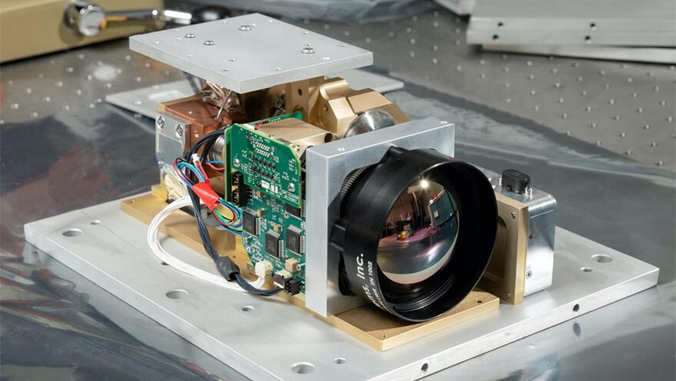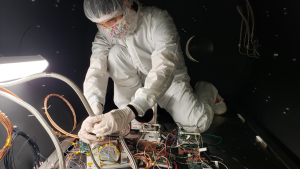
Due to its launch expertise, University of Hawaiʻi at Mānoa’s Hawaiʻi Space Flight Laboratory (HSFL) secured an $8 million technology demonstration mission funded by the NASA Earth Science Technology Office’s competitive In-Space Validation of Earth Science Technologies program, one of only 15 awarded since 2012.

The flagship HSFL project led by Hawaiʻi Institute of Geophysics and Planetology (HIGP) Director Robert Wright features HSFL’s Hyperspectral Thermal Imager (HyTI), a high-performance successor of its Space Ultra-Compact Hyperspectral Interferometer and TIRCIS technologies, in a 6U CubeSat (nanosatellite). The instrument uses a Fabry-Perot interferometer which splits light emitted by the materials that make up Earth’s surface and atmosphere, and from an orbit 400 km above Earth’s surface will allow HyTI to measure the chemical composition of gases, rocks, and soils based on their unique ‘spectral fingerprints.’
Built without any moving parts that can be damaged during launch, HyTI will deliver spatial resolution or image quality similar to the Landsat 9 satellite, currently the only U.S. satellite operating to observe the Earth’s surface. HyTI will offer even higher spectral resolution—which will help to identify and characterize materials and objects—greatly advancing the ability to study Earth system processes and broader applications.
“This technology demonstration mission is designed to be a pathfinder for a potential future science mission to show the capabilities and potential of HyTI,” said Wright. “As a CubeSat, HyTI is designed to work in constellations of 25–30 HyTIs during a larger science mission, which could then monitor volcanic gasses to predict eruptions or map soil moisture to aid crop management.”
HyTI will be delivered to NASA at the end of 2023, and will be launched on a Falcon 9 rocket as part of the SpaceX SpX-30 mission in early 2024. Advanced on-board computing will enable scientists to quickly access and analyze extremely high volumes of data.
Developing world-class technologies

From predicting volcanic eruptions in orbit, to analyzing soil composition from space, to detecting extraterrestrial life and improving space mission integration, HIGP has become a major player in advancing space exploration.
Renowned for its expertise in Earth and planetary science, HIGP bridges science and engineering, replicating the successful science-technology synergy that national laboratories like NASA’s Jet-Propulsion Laboratory (JPL) have created to pioneer aerospace research, analysis and cutting-edge technologies. Every year, HIGP brings in nearly $7 million for space-science initiatives through lucrative grants from agencies such as NASA, the Department of Defense and National Science Foundation—approximately half of which are dedicated to instrumentation development.
“Designing scientific measuring instruments is not necessarily difficult, but producing instruments that can take accurate measurements from a spacecraft, where size, weight, power and environment are an issue, is,” Wright said. “Our faculty, researchers and students have become experts in miniaturizing some of the most innovative measurement tools. This allows us to be at the forefront of space exploration and competitive for greater opportunities where we can have a bigger impact.”
The centerpiece of HIGP’s space science initiatives is HSFL, a multidisciplinary research and education center formed in collaboration with UH Mānoa’s School of Ocean and Earth Science and Technology and the College of Engineering.
Established in 2007, HSFL’s reputation and resources skyrocketed after leading the state’s first and only rocket launch in 2015, which allowed it to design and build world-class facilities with state-of-the-art equipment including: clean rooms; thermal vacuum chamber; vibration table; and an attitude determination and control testbed simulator. These resources have helped HIGP design, build, test and operate world-class space instrumentation.
Since then, HIGP has developed a string of successful NASA-funded technology development projects in collaboration with its Spectral Technology Group and Infrared and Raman Spectroscopy Laboratory, including the Airborne Hyperspectral Imager, HyTI, Thermal Infrared Compact Imaging Spectrometer (TIRCIS), and the Miniature Infrared Detector for Atmospheric Sciences.
The compact spectroscopic technologies use interference phenomenon to measure long-wave infrared spectral radiance data (between 8–11 microns) to remotely identify and characterize the chemical composition of solids, gases and liquids. The key technology was developed by HIGP faculty member Paul Lucey, and is used under license by local technology company, Spectrum Photonics.
In addition to measurement tools, HSFL has developed a Comprehensive Open-architecture Solution for Mission Operations System (COSMOS) that provides integrated flight software, ground station and mission operations for small satellites. Funded by NASA’s Space Grant and Established Program to Stimulate Competitive Research, COSMOS proved its success on the NEUTRON-1 CubeSat and is now an integral part of all HSFL missions.
For more, see Noelo’s 2023 story. Noelo is UH’s research magazine from the Office of the Vice President for Research and Innovation.

